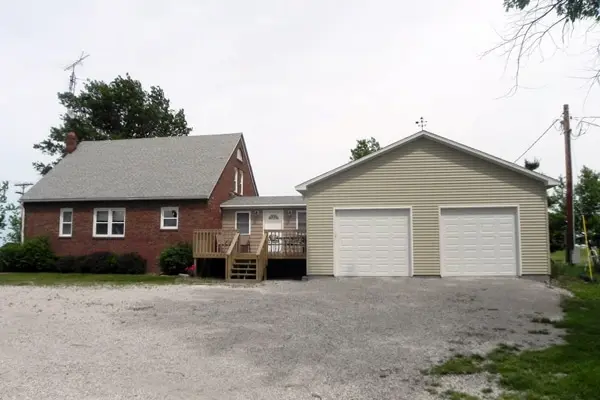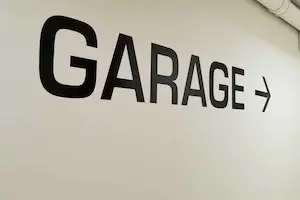Different Types of Garages (Complete Guide)
This post contains affiliate links.
The garage is one of the most important parts of a home, aside from the kitchen, bathroom, and bedroom. In fact, 75% of house buyers in America see garages as very important. This means you want to make sure your garage looks good.
However, this is where the headache starts. There are many garage types, and building and improving one may be difficult. How many types of garages are there?
Some of the most popular types of garages are:
- Attached Garage
- Detached Garage
- Integral Garage
- Breezeway / Portico
- Carport
- Portable Garage / Motor Port
- Front-Facing Garage
In this article, we explore the different types of garages. We also explore the parking layouts of a garage and the materials you need to build them. Finally, we look at the cost of building a brand-new garage and answer popular questions about garages.
How Many Types Of Garage Are There?
| Garage Type | Pros | Cons |
|---|---|---|
| Attached Garage | -No exposure to harsh weather. -Direct and fast access from your house. | -Not easily customizable outside. -Car fumes and other unpleasant smells can drift into the house. |
| Integral Garage | -No exposure to harsh weather. -Direct and fast access from your house. -Aesthetically complements your home. | -Car fumes and other unpleasant smells can drift into the house. -Noise from a workshop can be too loud for other occupants. |
| Detached Garage | -No car fumes drifting into your house. -No disturbing workshop noises to other occupants. -Can be almost anywhere on your property. -Lots of customization options. | -Exposure to weather. -No direct access from the house to the garage. |
| Breezeway/Portico | -No car exhaust or other smells carry from garage to house. -Protection from the weather during the transition to a car. | -It takes up some space. -It may be challenging to construct afterward. |
| Carports | -Cheap and fast to build. -Many sizes and customization available. -Prevents car glasses from freezing. | -Limited protection from weather. -Not suitable for storage. |
| Portable Garage | -Cheap and fast to erect. -Can be located almost anywhere. -Protects your vehicles from weather. -Prevents car glasses from freezing. | -Not suitable for storage. |
| Front-Facing Garage | -Convenient placement on either side of the house. | -Lack of privacy. -May need more security. |
| 90° Inward-Facing Garage | -Suitable for different floor plans. -More privacy compared to front-facing garage. | -May not use open space properly. |
| Side of the House Garage | -Good option for houses oriented side to the street. | -Lack of privacy. |
| Below the House Garage | -Offers great options for patios or rooms above the garage. -Heat travels up to the house. | -Noise may travel up to the house floors. |
| Barn/Loft Garage | -Plenty of space for workspace and living area. -Cost-effective living without long transitions to workplace. | -Costly construction. -Lack of privacy. -Costly to heat and cool. |
Attached Garage
The attached garage is probably the most common you will see. It is built and integrated with the house. This means you usually have a side door to access the garage from your house.
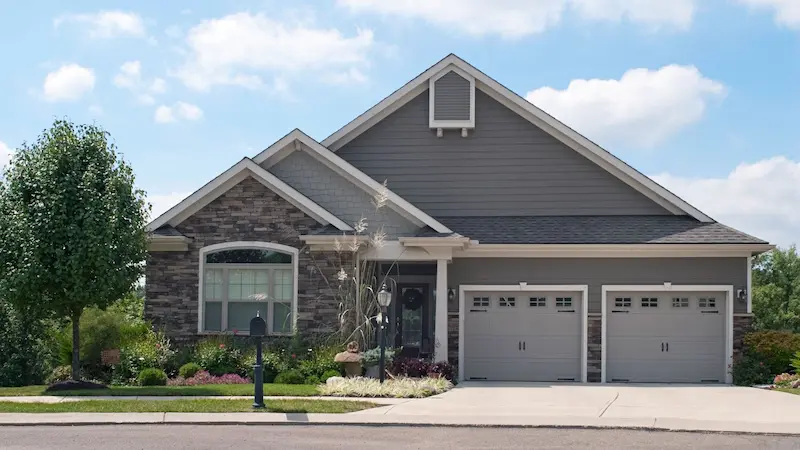
The attached garage is popular because most homeowners’ associations (HOA) like it. The attached garages are also disabled-friendly.
An attached garage is an excellent option if you live in colder areas. You drive into the garage and get out of the car warm and comfortable. You do not need to rush to your house.
The attached garage also makes accessing your things from your house easier. This means it is easier for you to store and retrieve things in your garage.
However, an attached garage also has its own issues. One of them is not as easily customizable. This is because it is part of the house.
For example, your garage’s exterior wall may also follow your house’s exterior wall. Painting the garage exterior wall to a different color just looks odd.
Another issue with the attached garage is car fumes. Suppose you leave your car in the garage for a long time. Take, for example, in the morning. In this case, you may smell car fumes in your house. This is because fumes can travel through the garage door and enter your home.
Detached Garage
Detached garages are not connected to your house. They are also a great option if your home doesn’t have a good garage door access point.
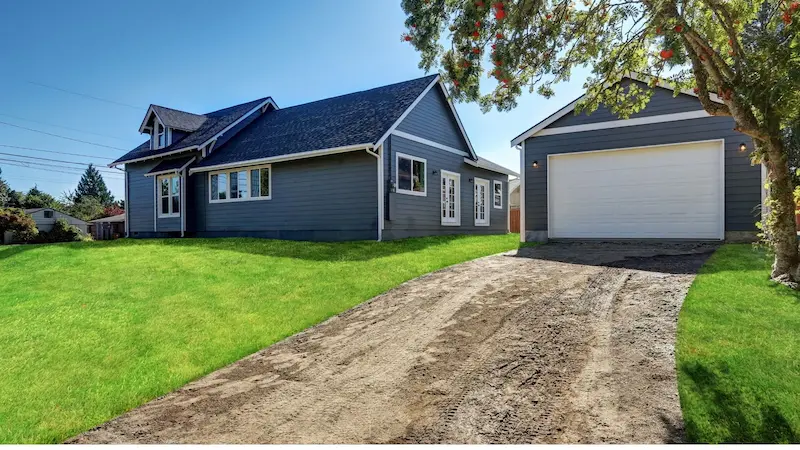
They can also be built anytime after the initial construction of the house. There are many options, from prefabricated to custom garages.
Detached garages can be almost anywhere on your property. They can be customized to look like your house, even if you build one afterward. This means you can apply some other exterior finish that makes your garage unique.
Detached garages are also great because they do not pass car fumes into your house. The attached garages do. Detached garages also make an excellent place for your workshop. This is because it can keep the loud noises from your garage away from your house.
However, detached garages do not have direct access to the house. This means you must expose yourself to the cold on your way home after you have parked your car. As a result, detached garages may not be popular in colder areas.
Before building a detached garage, ensure you check with your local authorities. This is because it is an independent structure. If you need more information on this, we have a guide on where you should build your detached garage.
Integral Garage
The integral garage is based on the word Integrate. This means the garage is integrated into the house, unlike an attached garage.
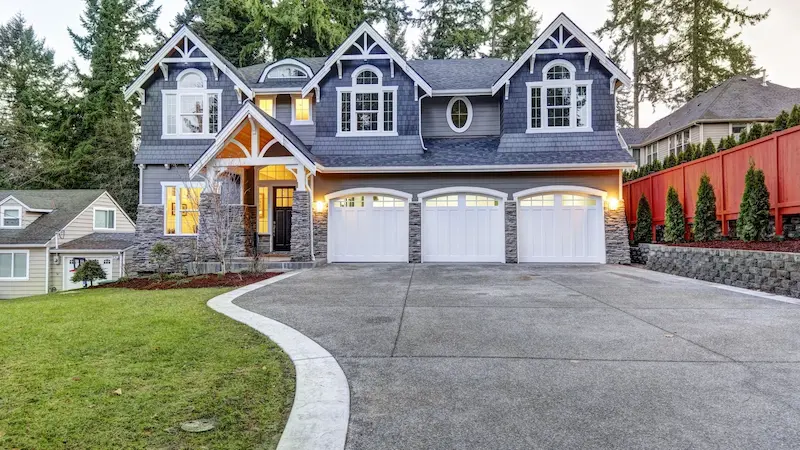
Home designers often work hard to integrate the garage into the home. As a result, they are very aesthetically pleasing. It is also very disabled-friendly since the garage integrates into the home.
Aside from the nice integration, an integral garage also brings benefits like attached garages. You are not exposed to the environment and directly access your home after you park your car. Storage and retrieving items from your garage are also easier.
However, the downsides of an integral garage are also quite similar to an attached garage. In fact, some may be worse. One is noise. If you use machinery in your garage, the noise will be heard loud in your house.
The car fume problem may also worsen since integral garages may pass fumes into the home even more easily. Your home may smell bad if you leave your car running too long.
Breezeway / Portico
Suppose you have a detached garage near your house. Opting for a breezeway is an excellent way to connect your garage and home.
A breezeway can be as simple as having a roofed walkway. Living in colder areas, you can wall up the entire path and insulate it for better temperature control. This should protect you from the weather when transitioning from home to the garage.
A breezeway is also a great space to store dirty boots and clothes. You can also wash a dog there. You can stay indoors while treating the space like an outdoor space.
Breezeway keeps car fumes away from your house. It can also provide protection from the weather as you travel from your house to your detached garage.
However, breezeways can be difficult to build. This is especially true if you build them after building your house and garage. This is exceptionally harder if your garage and house are on different elevations.
Breezeways can also take up space. As a result, you may find it harder to fully utilize the space inside your housing compound.
Carport
A carport is a semi-covered structure. Usually, it is open, with a roof to protect your car from the elements.
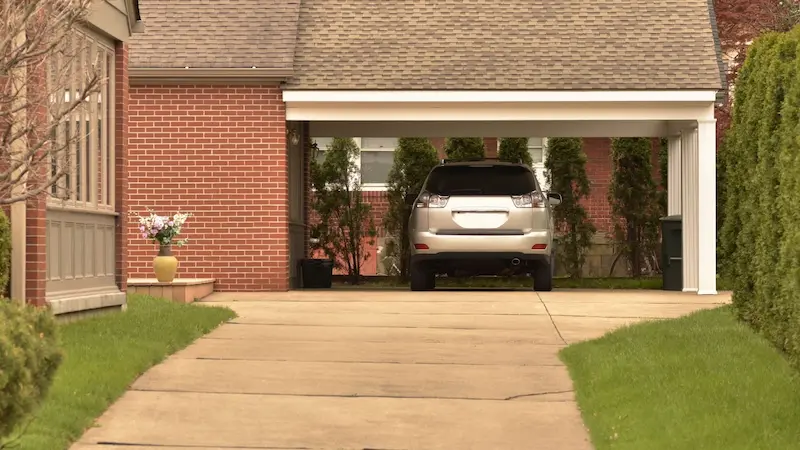
A carport does not have four walls; common carports may have one, two, or three-sided walls. Unlike garages, the structure can be free-standing or attached to your home wall.
Carports protect vehicles from sun, sap, snow, and falling debris. Carports are simple and fast to build from scratch, requiring little materials. You can also buy a prefabricated carport and put it up yourself.
However, carports offer limited protection to vehicles from the elements. You also cannot store things inside the carport. This is because you cannot really secure it from thieves.
Carports may be best if you need additional parking space. This can be the case if you have more cars than your garage can accommodate. Carports and walls can be made of wood, brick, stone, or other suitable materials to match your home style.
Read More: All About Carports
Portable Garage / Motor Port
Portable garages are a great way to temporarily protect your cars from the elements. These are non-permanent structures usually made from canvas, steel, or vinyl. Portable garages provide a durable covering and protection for your vehicles.
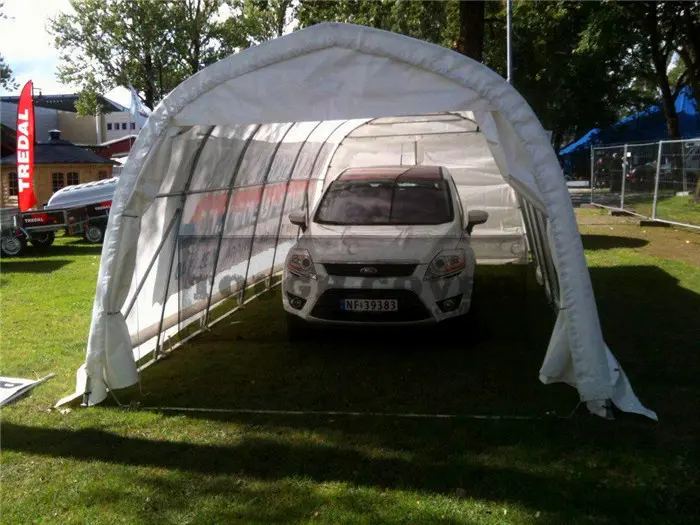
A portable garage is usually very easy to set up and dismantle. However, despite its non-permanent structure, a high-quality portable garage is surprisingly strong. They can withstand heavy wind and snow, keeping your cars safe.
Portable garages are also very customizable. You can have windows, doors, custom flooring, and more. Some even come with heating and cooling too. However, these add-ons are usually sold separately. This means your cost may go up if you want these options.
Portable garages are popular in residential that need residents to reduce clutter. This helps to keep a clean and organized homefront.
Portable garages can help cover up additional cars, boats, or RVs. This means residents can use a portable garage to comply with the rule.
Before setting up one, check with your local authorities on the rules for using them. This is because portable garages can be considered a structure and may have unique rules.
Read More: Alternatives For Garages
Front-Facing Garage
The front-facing garage is similar to an attached garage. However, the garage door faces the front, usually the street. In many cases, there is a driveway that allows you to drive off the street and park in the garage.
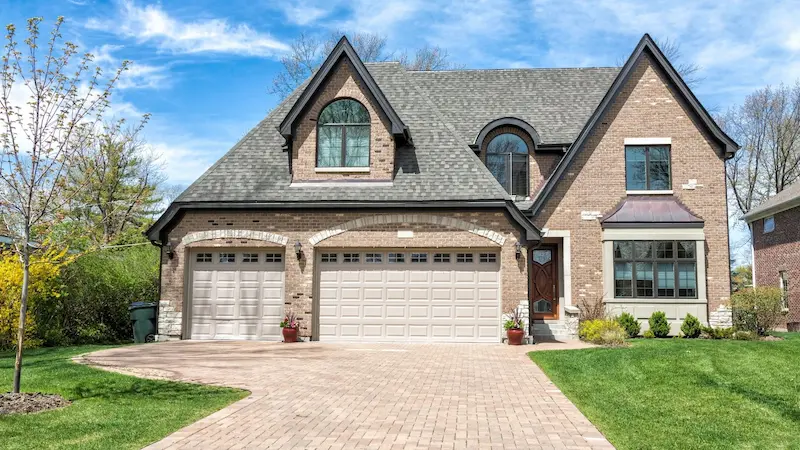
The front-facing garage is perfect if you have a house that faces the street. This is because you can easily access the garage from the street. A front-facing garage is also very aesthetically pleasing. They may be common in many suburban housing.
However, the front-facing garage may lack privacy. This is because if you leave your garage door open, it becomes visible from the street. If you have a messy garage that you prefer not to show people, this may not work well for you.
Another issue may be security. The front-facing garages may be slightly ‘inviting,’ including those with bad intentions. This is because the door is very visible from the street. As a result, your garage may be a thief magnet, attracting people to try to break into it.
To protect your garage better, consider installing security systems. These could be remote control garage door openers, cameras, and lighting.
Read More: Garage Security
90° Inward Facing Garage
90° inward-facing garages can be attached or detached. But, unlike the front-facing garage, it faces inward, usually 90° from your house door. This is a common garage setup, especially in the countryside or houses with larger land space.
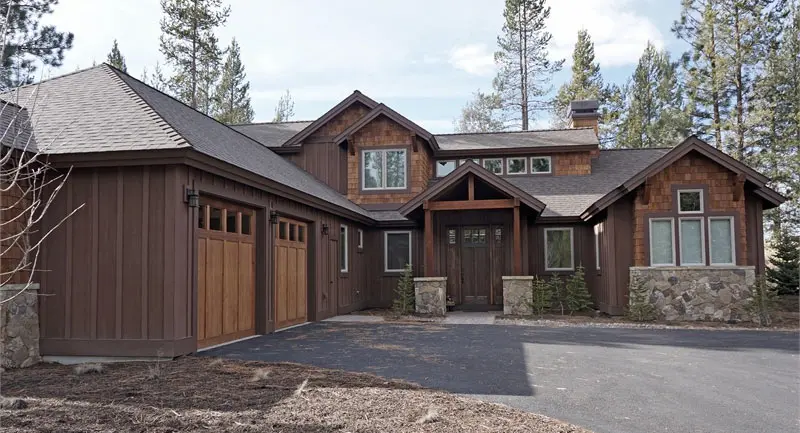
Inward facing garage has many benefits. One is that it gives you more privacy. This is because the door does not face the street but is 90° away from it. You can keep your garage messy or work in it without worrying people will see it.
It may also be more secure since it may not be as ‘inviting.’ Housebreakers or thieves may not notice your garage door too much. You may not need to spend too much on securing it.
However, a 90° inward facing garage may not be an efficient way to lay out your house. This is because it usually needs more space. As a result, you do not really see this type of garage in townhomes or in cities.
Side Of The House Garage
The side of the house garage can be attached or detached. However, the garage door faces sideways from the house’s main door. The garage is also accessed laterally rather than directly from the house’s main door side.
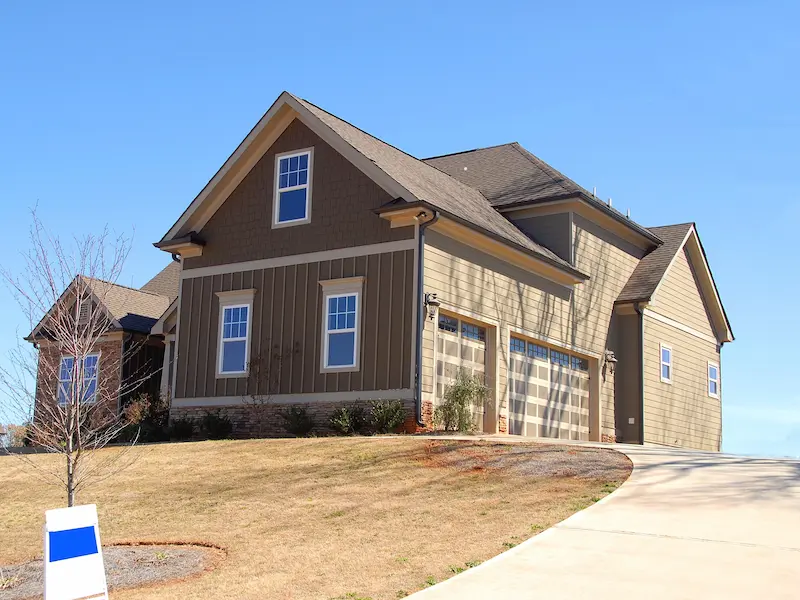
The side of the house garage may work very well for those with a house that does not face the main street. This means your garage can be built to face one and allow your car to access the street easily.
The side of a house garage also works well if you prefer to keep the garage door away from your house’s facade. This may be for privacy issues or aesthetics. The side of a house garage may be a popular way to integrate a garage into a home too.
Below The House Garage
Below the house garage is usually an integrated, attached garage. Usually, the house is a multi-story structure. The ground floor is the garage, while the living quarters are upstairs.
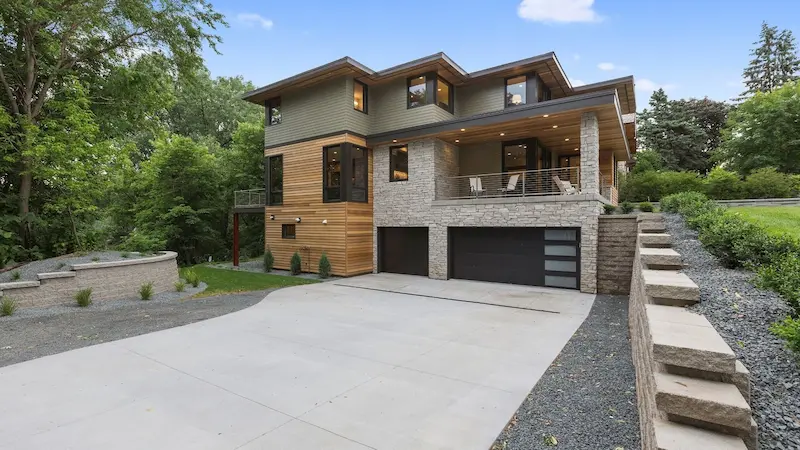
This type of garage is popular in places with land space premium, and larger houses tend to be built upwards. As a result, the house garage is often seen in townhouses or city dwellings.
Below the house garage may also be popular in hilly areas, where flat lands can be scarce.
One of the best things about the house garage is the ease of access. You can easily park your car downstairs. Then you take the stairs to go up your home. If you heat your garage, the heat may also travel up to your house, saving you heating bills.
The downside of the house garage should be the noise and possibly smell. The loud noise can easily travel to your living space if you use machinery. If you leave your car running in the garage, the fumes may make it into your house.
Barn/Loft Garage
The upstairs home garage is quite similar to the house garage. However, an upstairs home garage can be described as a ‘home in a garage.’ A below-the-house garage would be a ‘garage in a home.’
A typical upstairs home garage would be to have a huge open building. A loft is then built as a second level. The floor space is a garage, and the second level is a living space.
This arrangement is a dream to some since it allows an easy transition between work, life, and play. Everything is contained within one building. You also would usually have a large garage capable of parking many cars and hosting tools and machinery.
However, an upstairs home garage may cost a lot to build. This is because you must build a large, whole structure and a loft. You also need to insulate and secure the large place too.
Maintaining the property may also be difficult. Since it is a large space, it may cost a lot to heat and cool the space. You may also lack privacy since your living space is not very removed from the garage space.
What Materials Do You Use To Build A Garage?
Different materials may be used to build different parts of the garage. However, you can build most garages with wood, steel sheets, and roof shingles. You can install epoxy flooring, tiles, and some insulation for additional comfort.
If you are to build a garage, one of the biggest questions you may have is what you should use to build it. There are many options, and each comes with its strengths and weaknesses.
The key here is that you may use different materials for different parts of the garage. We list some of the popular materials for garage parts and explore why they are popular.
Structure
For structure, the most common materials are steel and wood. These are popular framing materials used for houses and garages. They are durable and strong.
Steel: Steel bars are the most common materials used to build garage structures. Based on your measurement, these bars usually come pre-cut and have holes drilled in.
You then arrange them and bolt the structure in place. You will need some help and machinery since they are heavy. But these steel bars practically last forever, with good care.
Wood: Another popular material used for structure work is wood. Typically hardwood such as oak is used to form the garage framing. This wood usually is durable and does not suffer from rusting like steel beams.
However, wood may bend over time as they age, especially if it is not dried enough when cutting them.
Walling
Walling refers to the interior and exterior materials you use to wall your framing. Popular options include metal walls, drywall, and wooden walls.
Metal Panels
The most common metal wall may be corrugated iron sheets. These are less common but may leave your garage looking very professional. They may be more expensive than wood or drywall, but they will last long.
The key is to protect your metal paneling from moisture, which may cause your iron sheets to rust over time. Insulation with waterproofing is usually a good combination here.
Dry Wall
Drywalls are also a popular material for walling your garage. They are exceptionally popular for walling the insides of a garage. Drywalls are made of calcium sulfate dihydrate, with a base sheet in between. Some may also use gypsum.
Drywalls are affordable; you can easily cut and modify them to fit your garage. They are also quite durable and have good strength too. The drywall, however, should not be used on the outdoor wall, as it may not handle the weather well.
Read More: Finishing the Garage Walls
Wooden Wall
If you like a more rustic, old-school finish, wooden walls may be a good option. There are plenty of options you can go with here. If you want something simple, use plywood or OSB boards as the inner wall of your garage.
For outer walls, you can use wood siding. Plywood may also work, although you want to ensure outdoor suitability. Check when shopping for plywood sheets for this.
Vinyl Plastic Resin
There are also plastic-based wall materials called vinyl plastic resin. You may hear them as vinyl walls. These are also good, viable options because they are affordable, light, and easy to install.
These panels are also durable and can handle indoor applications well. They also can be printed in many colors and designs. This allows you to interior decorate your garage too.
Roof
With roofing, the common materials are metal sheets and shingles. These are durable, weather-resistant materials. Your garage will get good shading and protection from them.
Metal Roofing
Prefabricated steel garages and carports usually come with steel roofs. Steel roof is a weather-resistant and durable choice for any garage type.
Metal roofing also comes in various colors, meaning you do not need to think about painting them. They are also easy to replace, as you simply rip the damaged piece and add a new one.
Shingles
Shingles are one of the most common materials for roofing for many good reasons. They look classic and rustic. Shingles can also last longer if adequately maintained.
Most houses also use singles as the roofing material. This means your house would have a matching look if your garage uses the same shingles.
Floors
Garage flooring is one area many may overlook. However, a garage should have proper flooring. This helps your garage to be easy to clean and has an organized look. There are many flooring options for garages, such as:
Concrete With Sealant
Some garage owners like their garage flooring to be bare concrete. The idea is that since they will spill some oil, grease, and all that, they might as well leave the floor untreated.
The issue with this approach is the floor will eventually get too dirty; it becomes an eyesore. A better approach would be to at least apply a layer of sealant on the bare concrete to protect it.
Epoxy
If you prefer to go another level higher, consider epoxy flooring. With epoxy flooring, you apply an epoxy-based layer on your concrete floor to protect it. Epoxy flooring is stronger. It is also more durable than a floor sealant.
You can also customize your epoxy flooring with colors. You can also be very creative and use epoxy of different colors to create effects. Some skillful specialists can create epoxy flooring that looks like marble.
Tiles
Floor tiles may be a more permanent flooring option and may also require the most work. This is because laying in floor tiles can take time and is labor intensive. Tiles can come in many types. Common types include porcelain, hard plastic, or vinyl.
However, tiles provide very good protection for your floor. They are also durable and easy to clean. The downside of tiles is they are less impact resistant. If you drop anything heavy on the tile, you may crack or break them.
Paint
You can also clean up the floor and paint it with epoxy paint. These, however, are not the same as epoxy flooring. Epoxy paint has much less epoxy, meaning the protection is not as good.
Suppose you choose to paint your garage floor. In this case, regularly paint and repaint your garage floor. This helps to maintain beautiful floors. You can also mix paint with anti-slip flakes or some epoxy.
Mats
If you want a low-cost and durable solution, check out plastic mats. They are affordable and easy to install. Once done, they cover the concrete floors well, instantly giving your garage a new look.
Plastic mats can be impact and weight resistant. However, they may not be too durable or scratch-resistant. When shopping for plastic mats, check on the installation process. This is because you want to avoid buying mats that do not match your concrete floor.
Some mats are glued to concrete. There are also roll-out, interlocking, and peel-and-stick types too.
Carpets
Finally, there is also an option to use a carpeted garage. This is uncommon, but it can be an option, especially if your garage is insulated. Carpets may be a good additional insulation layer if your garage is heated or cooled.
The issue with carpets in the garage is they can be hard to clean. If your garage is humid, it can turn moldy easily.
Suppose you are to install carpet on your garage floor. In this case, have a wet vacuum machine and regularly clean your carpets.
Read More: Garage Flooring
How Much Does It Cost To Build A Garage?
Building a garage may cost between $17,000 to $38,000 on average. The final cost depends on your garage size, location, and the materials you use to build your garage. If you hire out the construction work, the cost increases even more.
Another major question you may have when building a garage is the cost. How much does it cost to build a garage? Generally, a garage should set you back around $17,000 to $38,000 on average. However, the actual cost can depend on many factors.
Do understand that the price we list down here is a guide. Check with your builder for a quote before you start your work.
A typical build runs from $35 to $70 per square foot. If you are to build a carport, they cost $3,500 to $9,500 on average.
Large, luxury custom work with high-end materials like slate and brick costs $50,000 to $100,000. Adding a workshop or extra stalls could add another $10,000 to $40,000.
If you are looking to build a 1-car garage, be ready to pay $7,500 to $14,200. A 2-car garage costs $19,600 and $28,200. A 3-car garage ranges from $28,200 to $42,700.
A detached garage costs $15,000 to $55,000 or about 20% to 40% more than an attached garage. Some homeowners have reported costs of up to $120,000.
An attached garage costs $10,000 to $40,000. Some reports have them as high as $100,000. A two-story attached garage to extend living space can cost as much as $180,000.
Prefabricated garages cost $10,000 to $50,000. This is for most standard single and double-wide buildings. That price includes the unit, foundation, delivery, and installation. The unit alone costs $5,000 to $40,000.
If you go for a two-story and luxury prefabricated garage kit, the price tag can hit $95,000 or more.
A steel garage kit costs $4,000–$6,500. Prefab garages for a two-car space will generally start in the $5,000 price range.
Garage epoxy floors cost $1,500 to $3,000. Garage floor refinishing and polishing costs $3 to $10 per square foot. You can also use other flooring types, such as tiles. These should cost you around $1,500 to $4,500.
Building an apartment over a garage costs $175,000. But just extending a garage and adding another stall costs $10,000 to $25,000.
Read More: How Much Does it Cost to Build a Garage?
FAQ
Are There Houses With Unfinished Garages?
Yes. In some house projects, garages are usually left unfinished to save money. These garages have an external frame, and that’s it.
This type of garage can only be used to store cars and boxes of stuff. Some may have space to store tools, bikes, and sports equipment. If this is all you need from your garage, then you can leave your garage unfinished.
But, if you want a more aesthetically pleasing and functional garage, work on your garage. Finishing the garage means installing insulation depending on your location and climate.
You also want to complete the floors, walls, and ceilings. You can also install heating, cooling, and proper ventilation.
What Are The Parking Layouts For Garages?
There are several common parking layouts for garages. They are:
Single Bay 1 Door: For one car or small workspace and storing some items. It doesn’t have a lot of extra room. In most cases, a bigger garage is a good idea, especially for small homes. This is because you create new storage spaces.
Double-Wide 1 or 2 Doors: A widespread double-wide door is ideal for larger cars like trucks, SUVs, or vans. And you will only need one garage door opener. Double garage doors can also be a design element.
Garages like these offer a lot of space for storage. They can also be extended with overhead storage. Building a bigger two-car garage also offers space for a workshop.
3 Car Garage With One, Two, or 3 Doors: Big garages for three cars or 1-2 cars and lots of space for storage and workshop. These larger garages are an excellent option for any property with room.
You can store your kid’s cars, ridable lawnmowers, and lots of yards and common tools. You can also set up a workshop with a lot of machinery.
4-Car garage With 2/4 Doors: 4-car garages are huge and work well for big families with many cars. These offer endless options with storage space and maybe even separate work areas.
Tandem Garage: Tandem garages are rare. You may see them in properties with limited space for a garage. They usually fit two vehicles, but you need to park them nose-to-tail.
This means one car will be parked-in. This is not convenient if you have two cars that are used daily.
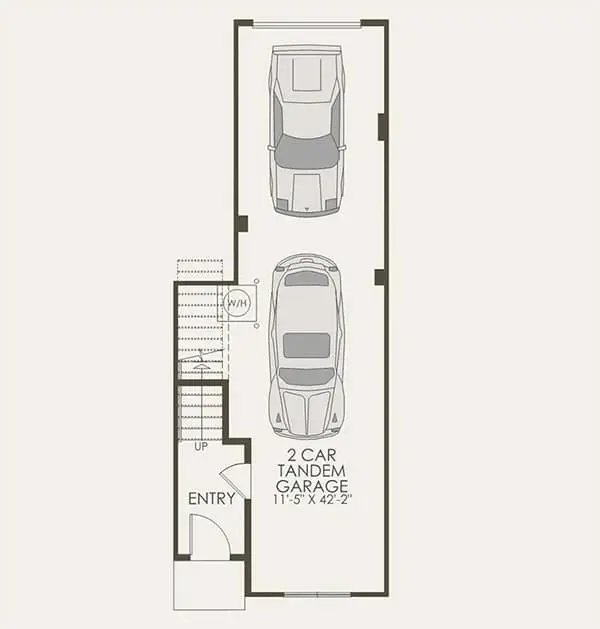
Can You Turn Your Garage Into A Workshop?
Yes, you can. In fact, it is a popular option with many. Turning your garage into a workshop allows it to be functional. You can also spend more time in it doing what you like.
Common workshops include woodworking, auto repairs, or electronic repairs. Sometimes, a garage workshop eventually becomes a business that makes money. Some corporations, such as Apple, Microsoft, and Google, were born out of garages.
Can You Turn Your Garage Into A Bedroom?
Yes, you can. Turning your garage into a bedroom can help create a new living space without you needing to build one. You can even rent the room out and make some money.
However, ensure you comply with building and safety codes. This is because garages are usually built for storage or work, not for living in. You also want to ensure the space is secure and insulated. Garages may not be as secure or well-insulated as a house.
How To Make My Garage Comfortable Year-Round?
You can make your garage comfortable year-round by doing two things. You can insulate and then regulate the climate inside.
Insulation helps to keep the outside air from making its way into your garage. This way, your garage stays cool even if the outside is hot. The same could be said about winter too.
Once you have insulation, you can not regulate the temperature inside. Install a heater or a cooler. They help to make the temperature comfortable. This way, you can work and play inside your garage all year round, summer or winter.

